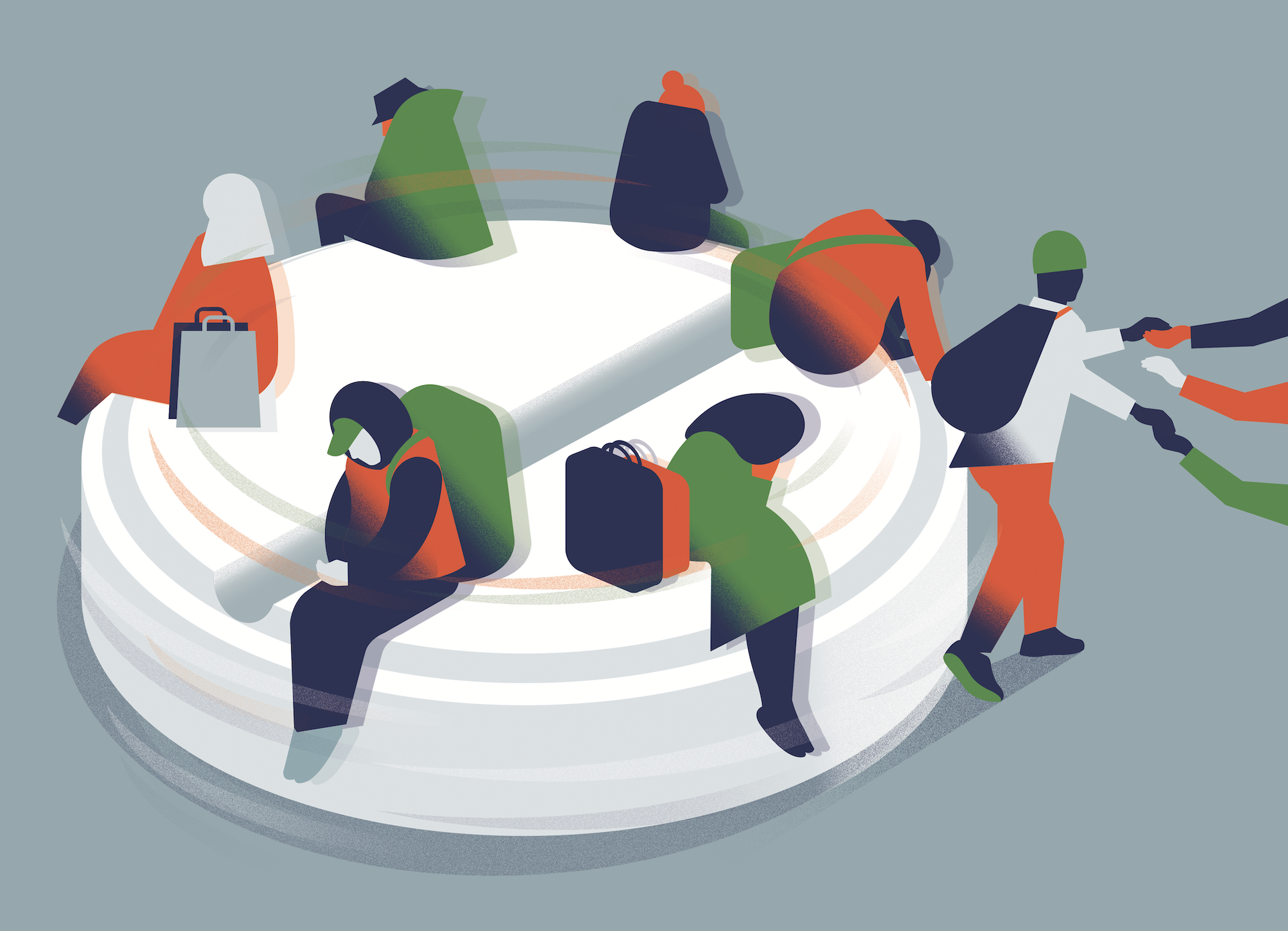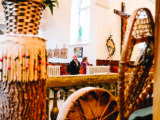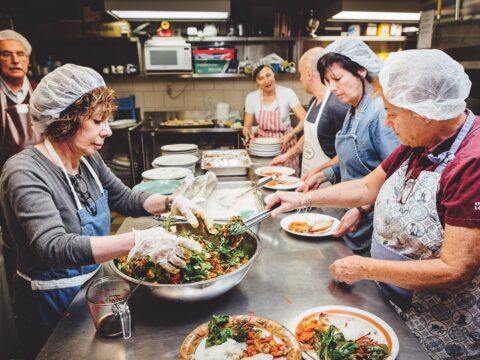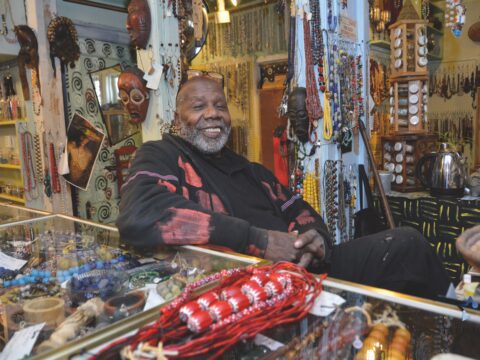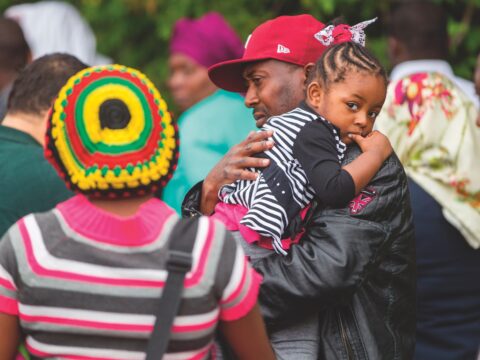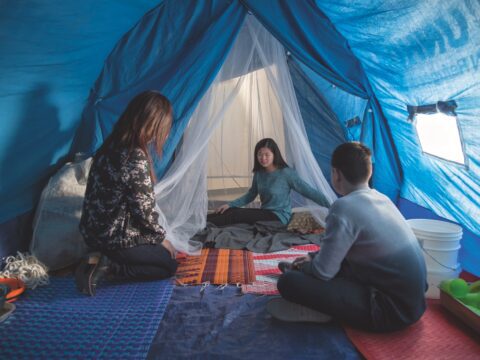It’s almost time for lunch at the Therapeutic Recovery Community on the outskirts of Victoria. In the kitchen, platters of chopped tomatoes and grated cheese are ready to be set out while chefs-of-the-day prepare the main courses. Nearby, in a lounge with walls of plants, bookshelves and comfortable chairs, a small group of men play a board game while others sit and read, taking advantage of the short pre-lunch break from meetings, skills training and the day-to-day jobs, such as growing food, cooking, cleaning and renovation work, that keep the community running.
Housed in a former youth custody centre, the building has undergone a transformation from its previous institutional style. It was redesigned to create an atmosphere where learning and healing can thrive, says Don Evans, executive officer of Our Place Society, a United Church-affiliated outreach mission that runs the community. “It means people feel they are being treated with respect. People will rise up to their surroundings.”
You may unsubscribe from any of our newsletters at any time.
The Therapeutic Recovery Community, which opened a year ago this month, is for men with repeat experiences of jail, homelessness and addiction. When full, it will house 50 residents who will stay for up to two years each. For those looking for change, the program offers help from doctors, nurses, a psychiatrist and clinical counsellors — but the key is peer support, with all residents taking a role in the community and senior peers eventually becoming leaders, teachers and mentors. Along the way, spiritual principles guide many aspects of the treatment, and meditation is encouraged.
It’s an innovative model, focused on breaking a destructive cycle. For years, staff at Our Place in downtown Victoria watched clients — struggling with addiction, mental illness, brain injury or trauma — move between jail and detox centres before landing back on the street. There, without skills or supports, they would again commit crimes to feed their addiction. “They weren’t being served anywhere else,” Evans says.
The need for an alternative came into sharper relief with the opioid crisis, which in 2018 saw an average of four British Columbians die every day from drug overdoses — the vast majority involving fentanyl.
More on Broadview: A letter to my opioid-addicted father
The opportunity for Our Place came in 2016. After months of community altercations over a large tent city on the grounds of the Victoria courthouse, Our Place set up a temporary shelter in a former youth jail. That shelter was supposed to shut after six months, but instead stayed open for almost two years because of a lack of housing. During that time, staff realized the self-contained facility would make an ideal site for a therapeutic recovery centre.
After Our Place made a full pitch, the provincial government came up with $4.7 million in funding, B.C. Housing provided $310,000 for renovations, Island Health earmarked $300,000 in annual operating funds to support clinical services and donors to Our Place made five-year pledges. (The government funding will decrease annually for seven years and be replaced with donations.)
One hurdle was persuading View Royal, the Victoria suburb where the centre is located, that the building should be rezoned. Some residents had objected to the shelter and many were unhappy it had remained open for longer than anticipated, so people were initially suspicious of the new proposal, according to View Royal Mayor David Screech. “Then we had a packed council meeting, and it was surprising the number of residents who spoke strongly about their personal experience with addiction and the need for this type of facility in our region,” he says.
Since the centre opened last October, Screech says, there have been no neighbourhood complaints. “I think this is desperately needed in Greater Victoria.”
Support worker Randy Smith is a role model for the 15 residents currently living at the community, and he points to his background as proof that therapeutic programs work. Two years ago, Smith completed the Guthrie House program for inmates with addictions at the Nanaimo (B.C.) Correctional Centre, which uses many similar ideas.
“Throughout my life, I have dealt with all sorts of traumas from sexual abuse to violence,” he says. “I was self-medicating with alcohol and drugs.…My drugs of choice were heroin, cocaine, speed, pretty much anything I could use.” He got involved with selling narcotics and served time in provincial and federal jails for drug and weapons offences. Treatment attempts had little success, and by the time of his last arrest, he had lost contact with his son, ex-wife and the rest of his family and was increasingly aware there were few options remaining.
“I had to make a choice,” he says. “I got involved in an [Alcoholics Anonymous] program, and one of the guys said, ‘You are incarcerated anyway — if you really want to change your life, you should go to Guthrie.’”
Smith hit the ground running, learning about trauma and what he needed to do to change his life. It especially helped to spend time with other participants in the program. “It’s one thing to speak with counsellors with degrees, but when I talked to guys who had been through exactly what I had been through and they were able to succeed, I was able to connect,” he says. “To see that it was possible to change was overwhelming and, with a little bit of encouragement, I realized that I could do it, too.”
In time, Smith became a mentor and leader in the Guthrie program, and after his release from jail 18 months ago, he set about changing his life. He took paramedic training and criminology courses at Vancouver Island University and says he now has an excellent relationship with his 14-year-old son and has rebuilt bridges with the rest of his family. “Guthrie helped me get my life back,” he says.
Now employed as a support worker at the Therapeutic Recovery Community, he spends his time helping other men work toward their own goals, talking to them about trauma and leading group discussions and meditation, which he personally practises on a daily basis. The key to success is that a person really has to want to change, he says, and residents are given the tools to make those changes.
“Your whole belief system has to change.”
Some come to the community through the courts, with judges using the program as an alternative to incarceration. Others are referred by the health authority or volunteer for the program while in jail. During the first three months, residents are stabilized and have no contact with friends or family. The second phase includes education, counselling and discovering individual talents, and the final reintegration stage is aimed at helping people achieve their goals. One of those aims is for residents to graduate from Grade 12 and attain skills that will help them become working, contributing members of society.
In the centre of the complex, an elaborate First Nations healing garden was recently completed, funded by a donation of $1 million. Frazer Smith, a Tsartlip First Nation elder, helps out at the centre twice a week, offering smudging, river baths and other Indigenous practices. He says he’s excited about the garden’s potential for helping Indigenous residents reconnect with their culture and spirituality.
Next will be a greenhouse, orchard and beehives, and there are long-term plans to open a public restaurant on the grounds to give practical experience to those training as chefs and servers.
Evans hopes that, in the future, Our Place will open similar facilities for women and youth. They’re also collecting data from the centre in hopes the province will be encouraged to open similar centres in other communities.
The enthusiasm of staff is palpable, but the first year has had rough patches. Since the centre opened, about half the people who started the program left before completing their term, Evans says. It’s too soon to track the overall recovery rate as the remaining residents have yet to “graduate” from the program. And with no senior residents, there are no role models or peer mentors for newer participants.
The centre is modelled on the San Patrignano community in Italy, which has a 72 percent recovery rate, but, even in his wildest dreams, Evans is not expecting such dramatic results from a highly troubled population where the current recovery rates are between one and two percent. “This is a lot more work than jail,” he says. “Change isn’t easy. Your whole life has to change, and if you have had a life of homelessness, incarceration and criminal thinking, you have tons of dysfunctional behaviours and attitudes. Your whole belief system has to change.”
Still, he hopes they can achieve 50 percent or better recovery rates once the centre gets through its growing pains — a rate better than anywhere else in Canada.
For Randy Smith, the verdict is already in. “I know the therapeutic model changed my life and thousands of other people’s lives,” he says. “I totally believe in this program. I know it can work. I have seen it for so many.”
This article first appeared in the October 2019 issue of Broadview with the title “Stopping the cycle.” For more of Broadview’s award-winning content, subscribe to the magazine today.

